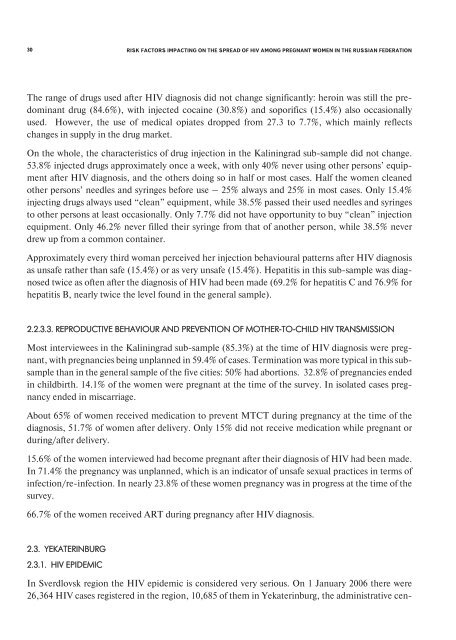risk factors impacting on the spread of hiv among pregnant women ...
risk factors impacting on the spread of hiv among pregnant women ...
risk factors impacting on the spread of hiv among pregnant women ...
Create successful ePaper yourself
Turn your PDF publications into a flip-book with our unique Google optimized e-Paper software.
30<br />
The range <strong>of</strong> drugs used after HIV diagnosis did not change significantly: heroin was still <strong>the</strong> predominant<br />
drug (84.6%), with injected cocaine (30.8%) and soporifics (15.4%) also occasi<strong>on</strong>ally<br />
used. However, <strong>the</strong> use <strong>of</strong> medical opiates dropped from 27.3 to 7.7%, which mainly reflects<br />
changes in supply in <strong>the</strong> drug market.<br />
On <strong>the</strong> whole, <strong>the</strong> characteristics <strong>of</strong> drug injecti<strong>on</strong> in <strong>the</strong> Kaliningrad sub-sample did not change.<br />
53.8% injected drugs approximately <strong>on</strong>ce a week, with <strong>on</strong>ly 40% never using o<strong>the</strong>r pers<strong>on</strong>s’ equipment<br />
after HIV diagnosis, and <strong>the</strong> o<strong>the</strong>rs doing so in half or most cases. Half <strong>the</strong> <strong>women</strong> cleaned<br />
o<strong>the</strong>r pers<strong>on</strong>s’ needles and syringes before use – 25% always and 25% in most cases. Only 15.4%<br />
injecting drugs always used “clean” equipment, while 38.5% passed <strong>the</strong>ir used needles and syringes<br />
to o<strong>the</strong>r pers<strong>on</strong>s at least occasi<strong>on</strong>ally. Only 7.7% did not have opportunity to buy “clean” injecti<strong>on</strong><br />
equipment. Only 46.2% never filled <strong>the</strong>ir syringe from that <strong>of</strong> ano<strong>the</strong>r pers<strong>on</strong>, while 38.5% never<br />
drew up from a comm<strong>on</strong> c<strong>on</strong>tainer.<br />
Approximately every third woman perceived her injecti<strong>on</strong> behavioural patterns after HIV diagnosis<br />
as unsafe ra<strong>the</strong>r than safe (15.4%) or as very unsafe (15.4%). Hepatitis in this sub-sample was diagnosed<br />
twice as <strong>of</strong>ten after <strong>the</strong> diagnosis <strong>of</strong> HIV had been made (69.2% for hepatitis С and 76.9% for<br />
hepatitis В, nearly twice <strong>the</strong> level found in <strong>the</strong> general sample).<br />
2.2.3.3. REPRODUCTIVE BEHAVIOUR AND PREVENTION OF MOTHER-TO-CHILD HIV TRANSMISSION<br />
Most interviewees in <strong>the</strong> Kaliningrad sub-sample (85.3%) at <strong>the</strong> time <strong>of</strong> HIV diagnosis were <strong>pregnant</strong>,<br />
with pregnancies being unplanned in 59.4% <strong>of</strong> cases. Terminati<strong>on</strong> was more typical in this subsample<br />
than in <strong>the</strong> general sample <strong>of</strong> <strong>the</strong> five cities: 50% had aborti<strong>on</strong>s. 32.8% <strong>of</strong> pregnancies ended<br />
in childbirth. 14.1% <strong>of</strong> <strong>the</strong> <strong>women</strong> were <strong>pregnant</strong> at <strong>the</strong> time <strong>of</strong> <strong>the</strong> survey. In isolated cases pregnancy<br />
ended in miscarriage.<br />
About 65% <strong>of</strong> <strong>women</strong> received medicati<strong>on</strong> to prevent MTCT during pregnancy at <strong>the</strong> time <strong>of</strong> <strong>the</strong><br />
diagnosis, 51.7% <strong>of</strong> <strong>women</strong> after delivery. Only 15% did not receive medicati<strong>on</strong> while <strong>pregnant</strong> or<br />
during/after delivery.<br />
15.6% <strong>of</strong> <strong>the</strong> <strong>women</strong> interviewed had become <strong>pregnant</strong> after <strong>the</strong>ir diagnosis <strong>of</strong> HIV had been made.<br />
In 71.4% <strong>the</strong> pregnancy was unplanned, which is an indicator <strong>of</strong> unsafe sexual practices in terms <strong>of</strong><br />
infecti<strong>on</strong>/re-infecti<strong>on</strong>. In nearly 23.8% <strong>of</strong> <strong>the</strong>se <strong>women</strong> pregnancy was in progress at <strong>the</strong> time <strong>of</strong> <strong>the</strong><br />
survey.<br />
66.7% <strong>of</strong> <strong>the</strong> <strong>women</strong> received ART during pregnancy after HIV diagnosis.<br />
2.3. YEKATERINBURG<br />
2.3.1. HIV EPIDEMIC<br />
RISK FACTORS IMPACTING ON THE SPREAD OF HIV AMONG PREGNANT WOMEN IN THE RUSSIAN FEDERATION<br />
In Sverdlovsk regi<strong>on</strong> <strong>the</strong> HIV epidemic is c<strong>on</strong>sidered very serious. On 1 January 2006 <strong>the</strong>re were<br />
26,364 HIV cases registered in <strong>the</strong> regi<strong>on</strong>, 10,685 <strong>of</strong> <strong>the</strong>m in Yekaterinburg, <strong>the</strong> administrative cen-
















